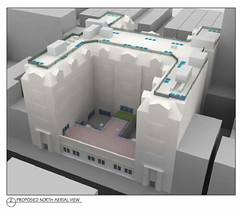After an initial disapproval from the Department of Buildings, a plan to turn the former P.S. 64 building into dorms has gotten its first nod of support from Community Board 3.
On Wednesday the Landmarks subcommittee voted to support developer Gregg Singer’s application for a Certificate of Appropriateness, concluding that changes would not radically alter the building’s facade and exterior space. (The “C of A” is a permit issued by the Landmarks Preservation Commission for work that also requires Department of Buildings approval.)
The updated building plans, posted to Community Board 3’s Website and reproduced below, show a ramp to the basement and a lift to its raised courtyard along East Ninth Street, both of which would improve wheelchair access. Additionally, all non-original fencing will be removed from the building’s grounds on the street level. The first-floor plans illustrate suite-style dorms with kitchens and bathrooms throughout.
The two most dramatic exterior changes will occur along East Tenth Street and on the building’s roof. The plans illustrate a raised, T-shaped courtyard space lined with railings. Two light wells border the courtyard and will open up the basement level of the building’s north side, and new doors and windows will open the previously closed space at street level.
On the roof, the plans show new staircase bulkheads and other mechanical equipment that will be surrounded by a series of small picket fences bordering the edge of the roof.
Amanda Davis, Director of Preservation at the Greenwich Village Society for Historic Preservation, attended last week’s meeting. She said that while the subcommittee remained concerned about the building’s intended use as dorms, the meeting’s purpose was only to certify that the plans would ensure the preservation of the landmarked building’s facade. Larger concerns about the project may come up when the subcommittee’s vote is considered by the Parks, Recreation, Cultural Affairs, Landmarks, and Waterfront committee and then by the full board, which makes the final recommendation to the Landmarks Preservation Commission.
Richard Moses of the Lower East Side Preservation Initiative said the new ramps and lift seem to be positive improvements to the building, but was skeptical about the roof space. “Our concern on the building’s exterior is that there’s a lot of new construction on the roof that seems like it would be very visible from the street,” he said. “We’d like to see visibility of any of these structures be as minimal as possible.” Mr. Moses said that while the fences seemed small and unobtrusive in the building plans, they are likely to be much larger and more obvious when they are built.
Andrew Berman, Executive Director the G.V.S.H.P., remained concerned about the building’s new purpose. “The restriction that the city attached to the property when it was sold under Rudy Giuliani was much too broad,” he said. “It simply said that the building needed to be used as a ‘community facility,’ which does include a broad range of uses, some of which are very good — like community centers, and health centers and nonprofit arts space. But it also includes things that don’t particularly benefit the community, like a private university’s dormitory.”





